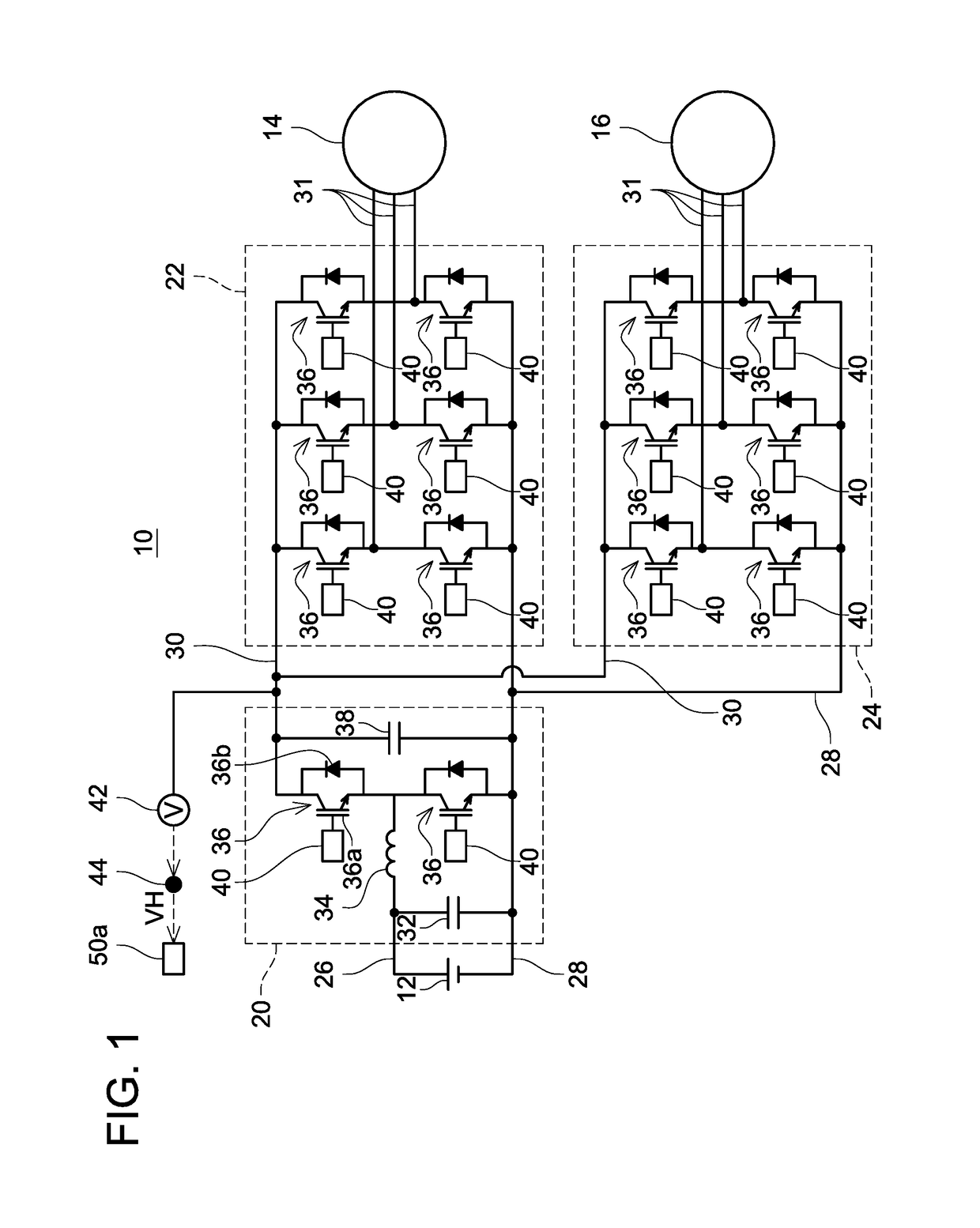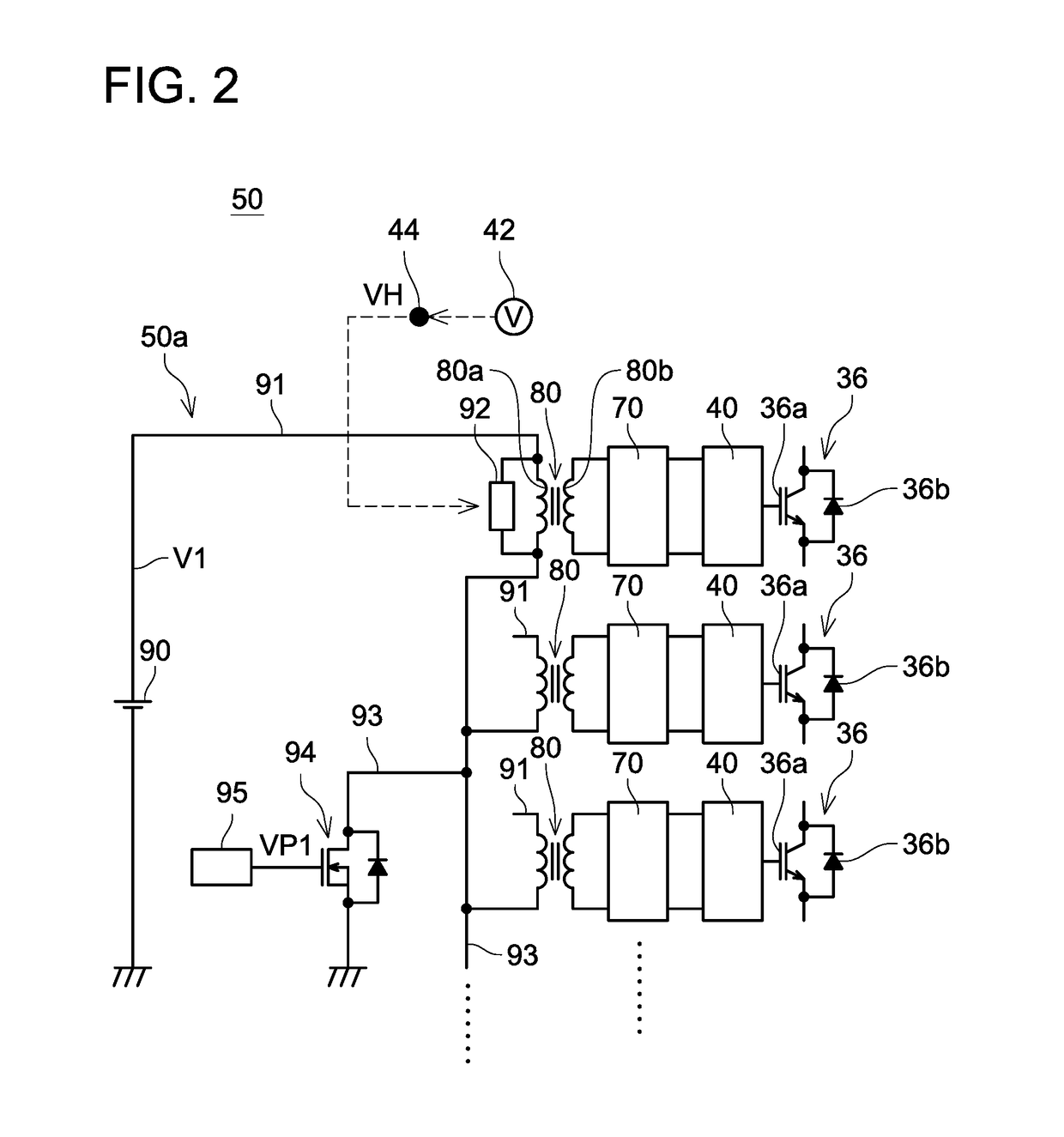Gate voltage control device
a gate voltage control and gate voltage technology, applied in the direction of process and machine control, instruments, pulse techniques, etc., can solve the problems of large size of isolation elements, difficult to directly connect them together, and large so as to reduce the size of gate voltage control devices
- Summary
- Abstract
- Description
- Claims
- Application Information
AI Technical Summary
Benefits of technology
Problems solved by technology
Method used
Image
Examples
first embodiment
[0024]A motor driving circuit 10 shown in FIG. 1 converts a DC voltage from a battery 12 into a three-phase AC voltage and supplies the same to motors 14, 16. The motor driving circuit 10 includes a converter circuit 20, a first inverter circuit 22, and a second inverter circuit 24. The battery 12 and the converter circuit 20 are connected by a first high-potential wiring 26 and a low-potential wiring 28. The converter circuit 20 and the first inverter circuit 22 are connected by a second high-potential wiring 30 and the low-potential wiring 28. The converter circuit 20 and the second inverter circuit 24 are connected by the second high-potential wiring 30 and the low-potential wiring 28.
[0025]The converter circuit 20 includes a smoothing capacitor 32, a reactor 34, two RC-IGBTs (Reverse Conducting Insulated Gate Bipolar Transistors) 36, and a smoothing capacitor 38. The reactor 34 is provided on the first high-potential wiring 26. The smoothing capacitor 32 is connected between the...
second embodiment
[0056]A gate voltage control circuit of the second embodiment differs from the gate voltage control circuit of the first embodiment in the operation of the signal transmission control device 92b. Other configurations of the gate voltage control circuit of the second embodiment are same as those of the gate voltage control circuit of the first embodiment.
[0057]FIG. 5 shows an operation of the gate voltage control circuit of the second embodiment. The operation of the gate voltage control circuit of the second embodiment during the period T1 (when the potential VH is larger than the reference value) is same as that of the gate voltage control circuit 50 of the first embodiment. The operation of the gate voltage control circuit of the second embodiment during the period T2 (when the potential VH is equal to or less than the reference value) is different from that of the gate voltage control circuit 50 of the first embodiment.
[0058]In the second embodiment, the signal transmission contr...
third embodiment
[0062]In the gate voltage control circuits 50 of the first and second embodiments, there may be some cases where detection of the intermediate voltage by the detection circuit 71 becomes difficult due to the generation of ringing. The gate voltage control circuit of the third embodiment suppresses an influence of the ringing and ensures the detection of the intermediate voltage. Firstly, issues related to the ringing will be described.
[0063]In the gate voltage control circuit 50 of the first embodiment, if sufficient charges are stored in the smoothing capacitors 73b, the current IL1 flowing in the primary coils 80a and the current IL2 flowing in the secondary coils 80b become small as shown in FIG. 6. In this case, the current IL2 attenuates to zero in a midst of the off-period Toff. Then, the ringing is generated at the timing when the current IL2 had attenuated to zero, and the voltages VL1, VL2 greatly fluctuate. Due to this, the detection circuit 71 cannot detect the intermedia...
PUM
 Login to View More
Login to View More Abstract
Description
Claims
Application Information
 Login to View More
Login to View More - R&D
- Intellectual Property
- Life Sciences
- Materials
- Tech Scout
- Unparalleled Data Quality
- Higher Quality Content
- 60% Fewer Hallucinations
Browse by: Latest US Patents, China's latest patents, Technical Efficacy Thesaurus, Application Domain, Technology Topic, Popular Technical Reports.
© 2025 PatSnap. All rights reserved.Legal|Privacy policy|Modern Slavery Act Transparency Statement|Sitemap|About US| Contact US: help@patsnap.com



